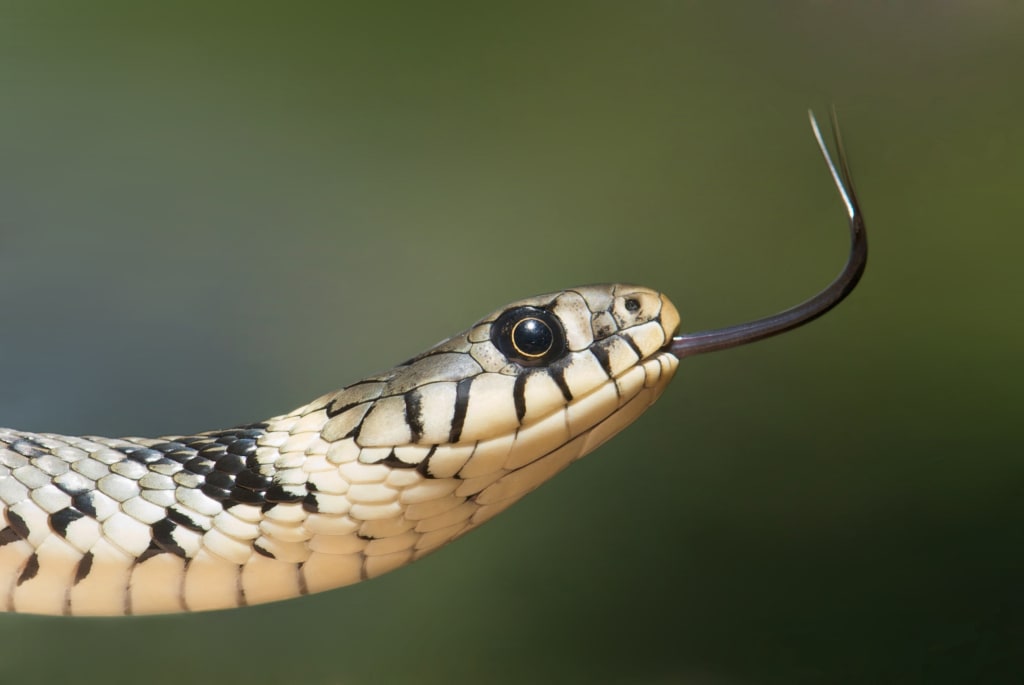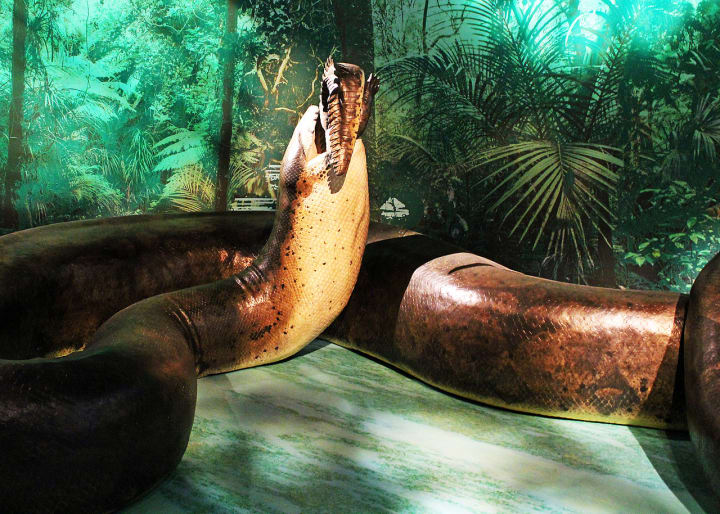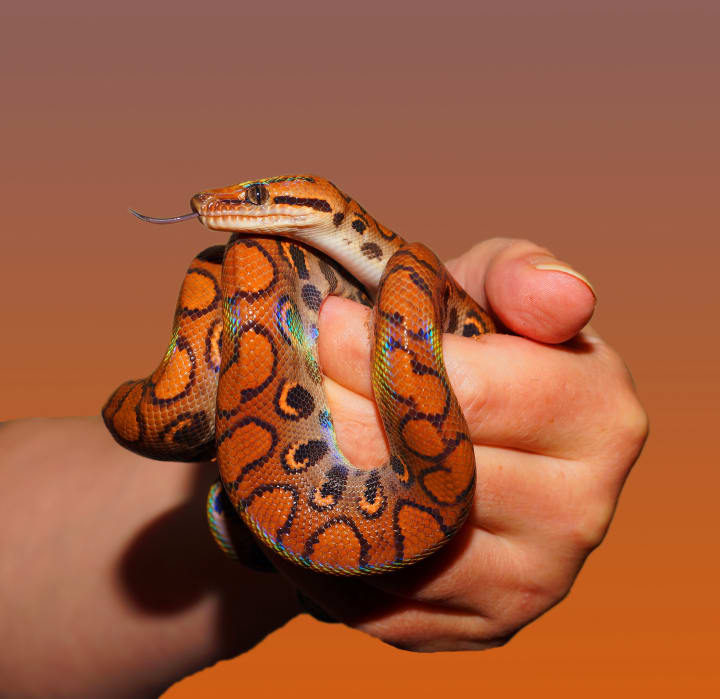Top 5 Misconceptions About Snakes
And Why They're Wrong

Intro
Long, forked tongue. Weird, emotionless eyes on top of flat, angular head. Sharp fangs in a mouth wide enough to swallow something (or someone) whole. Quick and alien movements. If you’re like many, these images conjure up a single, menacing word in your mind: snake. The creature that tricked Adam and Eve into eating the accursed apple and committing the first sin; inspiration for dozens of mythological creatures, and possibly more horror-based monster movies. The very thing that lurks in the shadows in the woods at night, waiting to sink its venom-dipped fangs straight into your bloodstream.
Snakes have long been regarded as fierce and dangerous animals. Awe-inspiring, perhaps, even fascinating, but decidedly strange. Their reptilian features are so starkly different from the soft, rounded traits we are so familiar with. Forest goers are warned about rattlesnakes, copperheads, or coral snakes lurking just outside of sight in the bushes, waiting to strike should you come too close.
Snakes are given a bad rep, and not always for good reason. Here I’ve listed a few common misconceptions about our weird scaly friends, and why they’re all wrong.
1) Careful—that snake's poisonous!
I know, I know, I’m splitting hairs—but hear me out. Snakes are not poisonous. With the exception of a few, rare species like the tiger keelback of eastern Asia, there are no poisonous snake species that we know about.
What? No poisonous snakes? Does that mean I’m safe?
Well, no. There are, however, venomous snakes—about 600, according to World Health Organization. That’s roughly 20% of all snakes species. That’s right, 20%. Not as much as you expected? As well, many of those species (400 out of 600) are only mildly venomous, and pose little to no medical threat to human beings.
So what’s the difference?
Simply put, venom is a toxin injected directly into the bloodstream, where poison is only toxic if ingested. Most snake venoms are neurotoxins, which are chemicals that directly affect the nervous system or brain. There are also hemotoxins—these affect the heart or blood—and cytotoxins, which only affect the tissue around the bite.
Most types of venom contain a mixture of toxins. All of these are designed to incapacitate prey so that the snake has a chance of finishing its meal before the rat, toad, frog, or even other snake has a chance to scurry away.
And a lot of these venoms can cause serious, life-threatening damage. Internal hemorrhaging, cardiac arrest, and paralysis are all potential effects of more toxic venoms.
If it were a snake… It probably wouldn’t have bitten you.
But a huge portion of venomous snakes are rear-fanged (such as the hognose or Indonesian garter snake). This means that not only isn’t their venom potent, but it’s hard to deliver. A single strike from their fangs won’t do it; they have to actually use their rear fangs and “chew” on the victim before any venom is released.
Additionally, there is a huge range in variety of toxicity between individual snakes in a species. No two snakes have the exact same venom. And it takes a lot of energy to bite, and even more to administer the dreaded toxins. They prefer to save their venom for a bite that’s likely to land them a meal. So, most defensive strikes are “dry bites,” in which no venom is released.
The likelihood of a snake biting you is extremely low, compared to the chance of being attacked by a cat or a dog. Being bitten by a venomous snake is much, much lower; and actually being given a venomous bite is extremely rare. According to a chart produced by Reptile Gardens, average bites per year by the top deadliest species ranges from 1-5. Per year. That’s minuscule compared to the 25 deadly dog bites between the years 1995 and 1996 alone (CDC).
Of course, there are a lot of factors to consider with the above statistics. Places like Southeast Asia, where more venomous species live than the US, have much higher snakebite casualty rates. Many states have extremely few venomous species; Ohio, for example, only has 3. And 2 of those are considered endangered in the state.
2) But snakes chase people down!
Snakes. Are not. Aggressive.
Snakes, in general, are not aggressive. I know—it’s a shocker. It’s unbelievable.
Don’t get me wrong. Snakes can and do bite. This is true for most animals, from rabbits to tiger and anything in between. But a snakes’ best and first defense is to run and hide. Even when provoked, snakes rarely strike humans. It takes a lot of energy. It brings them closer to danger. We’re bigger than they are and, in their mind, it’s much easier to just wait for us to leave, or try and find a means of escape.
It’s no secret where rattlesnakes get their name, but did you know that a huge number of snakes rattle their tails in defensive displays? It’s an easy way to make themselves sound like something bigger, or to momentarily startle a potential attacker long enough for them to make their escape.
Two more behaviors we commonly see in a threatened snake are feigned attacks and gaping. Especially so with venomous species, a defensive snake will open its mouth and hiss, showing you how big and terrifying its teeth are—this is gaping. Cottonmouths are famous for this (see video above). They may also feign charge or feign attack, by striking in the air or with their mouths closed in attempt to scare off predators.
Do snakes chase people down? No, they really, really don’t. They might feint-charge, to startle you away, but they don’t pursue. They have no reason to; it doesn’t benefit them, it doesn’t make sense for them. A lot of people tell stories about cottonmouths chasing them down while they’re walking along a riverside. What’s really happening—in most cases—is that said human is in the way of the snake’s hiding place, so it quickly slithers away to the comfortable shadows behind where the person happens to be standing.
And it makes sense to be afraid. A wild animal, suddenly moving really fast in your direction. But don’t read malicious intent into it. He was probably just trying to get home, away from the big, scary potential predator twenty times his size (that’s you).
3) Better safe than sorry. The only good snake is a dead snake!
Okay, so I’ve illustrated the fact that venomous snakes are rare (at least in North America), that they rarely bite, and that their bites are usually nonfatal. But there’s still a risk, you say. It could still be venomous. It could still kill me.
The thing is: you are much, much more likely not only to get bitten by your neighbor’s dog, but to die from that bite. So the danger level is much smaller when you encounter a potentially deadly snake. Do you shoot the stray dogs any time they come near you? Do you spend your weekends decapitating all of the stray cats you see on your way through the woods? Do you?
Probably (hopefully) not. Because it’s cruel and unnecessary. But it would be just as cruel to kill a cat as it would be to kill a snake simply on the merit of potential harm. And that’s not why you’ll kill a snake over a dog or cat—that’s not it at all. It’s statistically (and practically) true that dogs or cats are more likely to bite you than any snake is, yet one you fear—the other you don’t. Exactly why people hate snakes so much is an entirely different article, but the fact of the matter is that you want to kill them because they scare you, not because they could actually hurt you.
In fact, you are much more likely to get bitten by a snake in an attempt to kill, harm, or shoo it than if you simply turned around and ran. Snakes don’t chase people, and they won’t punish you for simply leaving them alone. The safest, sanest, and easiest thing to do if you see a snake and you don’t know what it is: simply step back, walk away, and leave in peace.
The Importance of Snakes
I probably don’t need to tell you that snakes are an essential part of the ecosystem, too. They eat small animals like mice and rats that easily overpopulate areas and carry disease. The presence of snakes in their natural habitat helps ensure ecological harmony; that is, they are key in preventing animals below them on the food chain from overtaking higher ones and throwing everything out of whack.
And snake venom has wide been used in medicine—it might even be used to cure cancer one day! Snake venom is incredibly adept at quickly dispatching healthy, live tissue. But researchers have found that venom is just as good at killing cancer cells.
(Disclaimer: Please don’t go around trying to pick up, hold, or interact with venomous snakes. For your sake as well as the snake’s!)
4) Some pythons are big enough to eat a grown man!
Let me stop you right there. No existing species of python is large enough to swallow a grown man. But what about x, x, and x anecdotes about a man in Indonesia eaten by a python? What about all the stories I’ve heard?
It’s within the small realm of possibility for one of the large boids (such as African rock pythons or green anacondas) to grow exceptionally large and attempt to eat an average-size grown man.
The few seemingly verifiable stories of grown men being eaten by large snakes are fundamentally flawed; the snake is never capable of actually successfully swallowing the man whole. Human shoulder blades are just too wide and broad, and don’t collapse like some prey.
And huge pythons have, in the past, eaten small children; but this is quite rare. Humans are not a common food source for these large constrictors. The main reason that these snakes might pose considerable threat is due to habitat destruction and the havoc that we as humans have wrecked on their environment, bringing us ever closer into their territory.
As well, most injuries by large constrictors are due to improper, or careless, handling by owners. And by large, I do not mean ball pythons or similar common pet snakes; I mean hefty, 12-foot Burmese pythons, anacondas, and reticulated pythons. These snakes come with their own risks simply due to their size; they should not be handled alone, for instance.
Even though they are usually not aggressive (although I’ve heard that retics can be real assholes), they can squeeze too tight, and might require a helping hand to get them back off. Those who keep these animals improperly, let them free roam, handle them too casually or intentionally antagonize them are at far greater risk of injury than the common layperson.
The exception, of course, to the “python big enough to eat a man” rule is one wonderfully huge extinct species, the Titanaboa (see photo below). These monsters were around 40 foot long, and spent a lot of the time in the water—where their huge body mass would be easier to support. They could eat just about anything or anyone, and have been used as inspiration for art, video games, movies, and more.
5) Snakes make terrible pets. People who keep snakes probably have emotional problems.
If you’re anything like me, you probably remember watching the Animal Planet docudrama “Fatal Attractions.” I thought, this will show me what it’s really like to own big cats, chimps, and other deadly exotic species. What I saw, instead, was PETA-esque propaganda painting anyone that owned reptiles—whether that be a four-foot ball python or a Komodo dragon—as irresponsible, fetishist and, very likely, disturbed.
According to the Insurance Information Institute, around 4.7 million people in the U.S. own pet reptiles. This is compared to 2.6 million that own horses, and around 60 million that own dogs (III).
Leopard geckos, corn snakes, and bearded dragons are some of the most commonly owned pet reptiles. Reptile supplies (not the animals themselves) is a billion dollar or more industry; most reptiles are bred and sold by small-scale breeders, with the exception of mass pet stores that get their reptiles from various sources.
There’s something singularly relaxing and zen about watching a snake move around its habitat. Holding them is extremely calming—that’s why people have started adding “snake massages” to their spa packages, claiming that the snakes are “specially trained” when they are, in fact, just doing what comes natural to them. The smooth scales over strong muscles they use in lieu of legs can be very therapeutic.
With the exception of heat (and occasionally light) requirements, snakes are easy to care for; most of them don’t need to eat more than once a week, poop just as often, and don’t get stressed out if you forget to hold them for a while. They need enrichment and care like any animal, but they don’t need walks, they don’t need toys. They don’t except much from you, like a dog might. Just give them enough space, a good hot spot, some comfortable hides and the occasional frozen mouse and you’ll have an animal that can bring you joy for upwards of 30 years.
Most pet snakes—at least the ones you’ll get at common pet stores—are extremely docile, more so than most small animals (way less likely to bite than a dwarf hamster!) and completely harmless. Most bites, when they do happen, are quick strikes; very rarely do snakes “latch on” when they bite, because most of them are smart enough to realize humans are a little bit too big to eat.
Whether or not snakes feel affection for their owners is an entirely different matter; but it’s certain that they do, at the very least, learn to accept and even favor your presence. Even if they don’t love you back, you loving them is enough to lower stress levels.
(Did I just sound like an ad for a moment? I just really like snakes, man.)
Pet snakes are even used as therapy animals in some cases. An article from US Herp tells about a corn snake that’s been used to treat depression in certain patients. Owning pets in general is beneficial; just watching and holding them can improve mood, reduce feelings of loneliness, and lessen stress levels.
Autistic spectrum individuals often use pets, including reptiles, therapeutically; they provide a calming presence, steady companionship, and a social skills booster. People with severe anxiety and an affinity for reptiles find comfort in their scaly pets.
People have hated and feared snakes for millennia. It's time to move past that—and education, in my opinion, is key. I may not have grown up to love snakes the way I do if I hadn't had those first two or three positive interactions with them as a kid. I can still remember the first time I held a snake—a black rat snake at a museum. It was so much fun! Now they're one of my favorite animals, and it makes me really, really tired when people talk about how they'll kill any snake they see "just to be safe."
If you can look past the fear, disgust, and horror that society has deeply ingrained in us about snakes, and see them as any other living thing, you’ll realize that they’re actually really cool, useful animals to have around. You might even think they’re beautiful.

Famous sculpture of what Titanaboa may have looked like.

A baby rainbow boa. Some snakes are beautifully iridescent, like this one.

The corn snake; possibly the single most popular pet reptile in America. And for good reason too! Look at those vibrant colors! That dopey face.
About the Creator
Felecia Burgett
Novice writer, amateur novelist, poet, article writer, dabble, and animal lover.






Comments
There are no comments for this story
Be the first to respond and start the conversation.